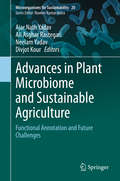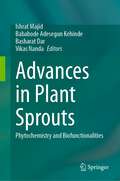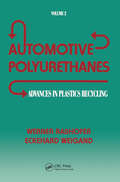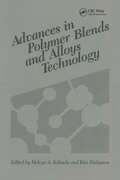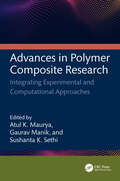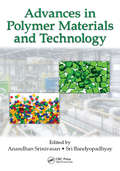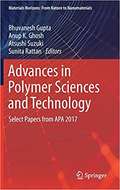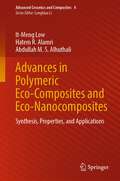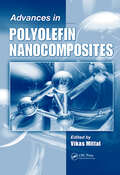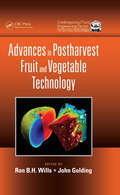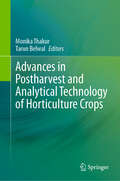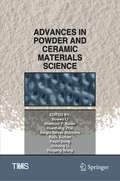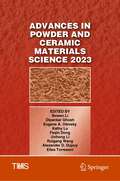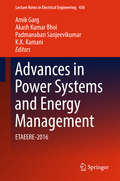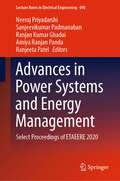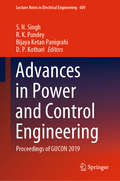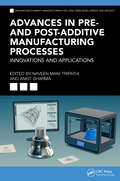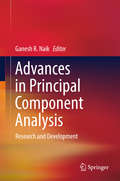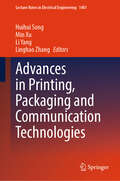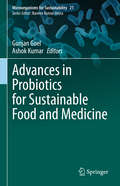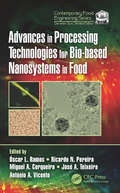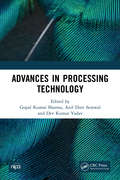- Table View
- List View
Advances in Plant Microbiome and Sustainable Agriculture: Functional Annotation and Future Challenges (Microorganisms for Sustainability #20)
by Ajar Nath Yadav Ali Asghar Rastegari Neelam Yadav Divjot KourMicrobes are ubiquitous in nature, and plant-microbe interactions are a key strategy for colonizing diverse habitats. The plant microbiome (epiphytic, endophytic and rhizospheric) plays an important role in plant growth and development and soil health. Further, rhizospheric soil is a valuable natural resource, hosting hotspots of microbes, and is vital in the maintenance of global nutrient balance and ecosystem function. The term endophytic microbes refers to those microorganisms that colonize the interior the plants. The phyllosphere is a common niche for synergism between microbes and plants and includes the leaf surface. The diverse group of microbes are key components of soil-plant systems, and where they are engaged in an extensive network of interactions in the rhizosphere/endophytic/phyllospheric they have emerged as an important and promising tool for sustainable agriculture. Plant microbiomes help to directly or indirectly promote plant growth using plant growth promoting attributes, and could potentially be used as biofertilizers/bioinoculants in place of chemical fertilizers. This book allows readers to gain an understanding of microbial diversity associated with plant systems and their role in plant growth, and soil health. Offering an overview of the state of the art in plant microbiomes and their potential biotechnological applications in agriculture and allied sectors, it is a valuable resource for scientists, researchers and students in the field of microbiology, biotechnology, agriculture, molecular biology, environmental biology and related subjects.
Advances in Plant Sprouts: Phytochemistry and Biofunctionalities
by Vikas Nanda Ishrat Majid Bababode Adesegun Kehinde Basharat DarThe demand for plant foods in all global markets has been increasing along with awareness of greenhouse gases generated from animal farming, expanded sentiments against animal slaughtering and common perception of the health benefits of plant food products. Accordingly, more attention has been placed on green processing of plant foods for the optimization of their nutritional and health benefits. Sprouted vegetable products have been studied and reported in many scientific investigations to qualitatively improve the phytochemistry, enhance the nutritional profile and improve the biological functionality potentials of such vegetables beyond their initial natural states. Vegetable sprouts have been reported to possess aspects that make them serviceable for the management of metabolic syndrome disorders such as diabetes, hypertension, cancer and other health issues related to cellular oxidation of body cells, and antimicrobial bioactive components have been isolated from vegetable sprouts. Advances in Plant Sprouts: Phytochemistry and Biofunctionalities provides a singular source on recent advances in studies about the dietetic and nutraceutical potencies of vegetable sprouts and increases awareness on the possibility of processing plant foods to make them more nutritionally beneficial. Green production is another important aspect of this text since plant foods processed by sprouting are free of agrochemicals, consume less energy and utilize less manpower, making them easy to produce and environmentally friendly as well. Consumption and production of sprouted vegetables has been increasing in recent years, and this text covers the production and nutritional aspects of all the major sprout groups.
Advances in Plastics: Automotive Polyurethanes, Volume II
by Werner Rasshofer Eckehard WeigandThe technology for the recovery, reprocessing and reuse of automotive polyurethanes in Europe is highly developed and serves as a successful example for other areas. This new book by a leading authority on this technology details the materials and methods, as well as the problems, involved in this work. Going beyond recovery, the authors examine the processes and applications involved in putting recovered material to economic use in marketable products. The text is supplemented with more than 60 tables providing useful data on polyurethane recycling processes and chemistry. More than 60 photographs, micrographs, diagrams and flowcharts illustrate materials, processes and products. In addition to a detailed presentation of this technology, the book provides a review of European regulation and programs dealing with automotive plastics recycling, as well as the voluntary activities of industry organizations and individual companies. The information in this new book will be useful to personnel involved in the research, development and recycling of plastics and other polymeric materials for automotive applications. The details of reprocessing chemistry will be especially useful to polymer chemists working with polyurethanes. TablesMuch of the technical data in this book is presented in 64 tables. Here is a small sample of this material: o Plastic Components in Used Cars… o Reaction conditions for glycolysis of the Bayflex 110-80 System o Parameters of the Continuous Pebra-Magna Glycolysis Process o Physical Properties of RIM Polyurethanes Obtained by Using Glycolysis Polyols (20% Filler) o Comparison of the Mechanical Properties Baydur® STR from Virgin Polyol and from 70% RRIM Recycled Polyol o Flame Retardant Behavior of Adhesive-Pressed Boards Based on EA Foam Illustrations More than 60 photographs, micrographs, flowcharts and diagrams illustrated processes and materials, including finished products made of recycled polyurethanes. Here is a
Advances in Polymer Blends and Alloys Technology, Volume II
by Kier FinlaysonFrom Reports in Volume 5: "Recently polymer blends have emerged as one of the most important areas of research activity in the field of polymer science and technology. Because of their satisfactory performance in meeting specific needs of the polymer industry, they have drawn considerable attention in replacing not only many conventional materials, but also some of the polymers that are in vogue. By suitably varying the blend compositions and manipulating the processing conditions, tailor-made products with a unique set of end use properties can be achieved at a much lower cost and within a shorter time than would have been necessary for the development of a new polymer. The usefulness of such blends increases with the increasing range of applications of this type of materials." (Chapter 4) "New and growing demands on polymeric materials cannot be satisfied in future by an assortment extension of basic polymers. Although the introduction of new major-use basic polymer is possible, it seems unlikely in view of current projected economic and technical considerations. On the other hand, new products based on the modification of existing polymers have and will continue to be fruitful areas for both scientific and commercial developments. The driving forces for these developments are: 1. Improved performance, 2. Reduced cost, 3. Present, pending and future legislation dealing with health and environmental issues." (Chapter 11)
Advances in Polymer Composite Research: Integrating Experimental and Computational Approaches
by Gaurav Manik Sushanta K. Sethi Atul K. MauryaThis book emphasizes the importance of experimental characterization techniques and computational modeling tools in polymer composites. The topics covered include finite element analysis, computational fluid dynamics, molecular dynamics simulations, machine learning, material informatics, multiscale modeling, advanced characterization techniques, and the emerging field of nanocomposites. Each chapter provides detailed discussions, case studies, and examples to illustrate the practical application of these techniques in polymer composite research.Features: Offers a comprehensive exploration of polymer composites encompassing both experimental and computational approaches. Showcases most recent findings, methodologies, technologies, and applications in the field. Explores real-world case studies, industrial applications, and potential commercialization opportunities. Discusses the understanding, analysis, and design of polymer composites. Includes LAMMPS-, Ansys-, ABAQUS-, and Materials Studio-based simulation examples. This book is aimed at graduate students and researchers in polymers, polymer composites, and materials science.
Advances in Polymer Materials and Technology
by Anandhan Srinivasan Sri BandyopadhyayThis book covers recent advancements in the field of polymer science and technology. Frontiers areas, such as polymers based on bio-sources, polymer based ferroelectrics, polymer nanocomposites for capacitors, food packaging and electronic packaging, piezoelectric sensors, polymers from renewable resources, superhydrophobic materials and electrospinning are topics of discussion. The contributors to this book are expert researchers from various academic institutes and industries from around the world.
Advances in Polymer Processing 2020: Proceedings of the International Symposium on Plastics Technology
by Christian Hopmann Rainer DahlmannThis book gathers the proceedings of the International Symposium on Plastics Technology, which was held on March 10, 2020 in Aachen, Germany, and was organised by the Institute for Plastics Processing (IKV) in Industry and Craft at RWTH Aachen University. Peer-reviewed by an international scientific committee, the conference proceedings comprise the papers presented by the international speakers. Topics covered include - circular economy- extrusion- lightweight technologies- simulation and digitisation - injection moulding- hybrid materials and additive manufacturing. In these fields, key themes for plastics technologies have been identified that will shape the face of research and industry for the next decade. In their contributions, the authors present the latest scientific findings, and discuss topical issues in plastics technologies. The symposium offered an inspiring forum for the exchange on research and innovation, for discussing urgent questions and providing impulses for the future of plastics technology.
Advances in Polymer Sciences and Technology: Select Papers from APA 2017 (Materials Horizons: From Nature to Nanomaterials)
by Anup K. Ghosh Sunita Rattan Bhuvanesh Gupta Atsushi SuzukiThis book presents select papers presented at the annual meeting of the Asian Polymer Association. The chapters in this volume document and report on a wide range of significant recent results for various applications, as well as scientific developments in the areas of polymer science and engineering. The chapters include original research from all areas of polymer science and technology with a focus on the manufacture, processing, analysis and application of long chain polymer molecules. This book will be of interest to researchers in academia and industry alike.
Advances in Polymeric Eco-Composites and Eco-Nanocomposites: Synthesis, Properties, and Applications (Advanced Ceramics and Composites #4)
by It-Meng Low Hatem R. Alamri Abdullah M. AlhuthaliThis book provides an overview on the latest advances in the synthesis, properties and applications of polymeric eco-composites and eco-nanocomposites reinforced natural fibers (e.g. pulp-fiber, flax, etc.) and nanofillers (e.g. organoclay, nano-SiC, etc.). Potential challenges and future directions of these composites are highlighted and addressed. This book offers numerous graphs and electron micrographs for easy understanding by students, researchers and practicing engineers.
Advances in Polyolefin Nanocomposites
by Vikas MittalWith the advent of polymer nanocomposites, research on polyolefin nanocomposites has grown exponentially. Correcting the deficiency of a meaningful text on these important materials, Advances in Polyolefin Nanocomposites:Sums up recent advances in nanoscale dispersion of filler in polyolefinsPresents a basic introduction to polyolefin nanocomposite
Advances in Postharvest Fruit and Vegetable Technology (Contemporary Food Engineering Ser.)
by John Golding Ron B.H. WillsAdvances in Postharvest Fruit and Vegetable Technology examines how changes in community attitudes and associated pressures on industry are demanding changes in the way technology is used to minimize postharvest loss and maintain product quality. In particular, the book discusses important drivers for change, including:Using more natural chemicals
Advances in Postharvest and Analytical Technology of Horticulture Crops
by Monika Thakur Tarun BelwalThis book discusses advances in postharvest and analytical technology for horticulture crops and challenges to meet future needs. The horticulture crops (fruits and vegetables) need a systematic and scientific postharvest handling and management system for securing both physical and chemical attributes while prolonging their shelf life. Postharvest technologies include storage, drying, packaging, extraction of components, and preparation of juice and wine from the collected fruits and vegetables. All these postharvest technologies have emerged and evolved with time to provide meaningful solutions to minimize food loss, maintain quality, and provide fast processing of horticulture crops. Parallel development of analytical techniques has also evolved to monitor the quality of fruits and vegetables during postharvest processing and thus provide a rapid and efficient method for delivering safer food products. This book provides an overview of different postharvest technologies, their mechanisms, and their effect on the quality of horticulture crops. It also emphasizes the assessment of each advanced technology, including its limitations and advantages. Overall, this book provides techniques, research, mechanisms, advances, and challenges of postharvest and analytical technologies for horticulture crops, along with recommendations for future research directions.
Advances in Powder and Ceramic Materials Science (The Minerals, Metals & Materials Series)
by Sergio Neves Monteiro Bowen Li Faqin Dong Shefford P. Baker Huazhang Zhai Rajiv Soman Jinhong Li Ruigang WangThis collection emphasizes the advances of powder and ceramic materials in fundamental research, technology development, and industrial applications. Ceramic materials science covers the science and technology of creating objects from inorganic, nonmetallic materials, and includes design, synthesis, and fabrication of ceramics, glasses, advanced concretes, and ceramic-metal composites.
Advances in Powder and Ceramic Materials Science 2023 (The Minerals, Metals & Materials Series)
by Kathy Lu Bowen Li Faqin Dong Eugene A. Olevsky Jinhong Li Ruigang Wang Dipankar Ghosh Alexander D. Dupuy Elisa TorresaniThis collection emphasizes the advances of powder and ceramic/glass materials in the fundamental research, technology development, and industrial applications. Ceramic materials science covers the science and technology of creating objects from inorganic, non-metallic materials, and includes design, synthesis, and fabrication of ceramics, glasses, advanced concretes, and ceramic-metal composites. In recent years, the hybrids of ceramic and metallic materials have received plenty of interdisciplinary inspirations and achievements in material processes and functional applications including ionic conductors, catalysis, energy conversion and storage, superconductors, semiconductor, filtrations, etc. Topics cover, but are not limited to:· Silicates, oxides, and non-oxide ceramics and glasses · Synthesis, characterization, modeling, and simulation of ceramic materials · Design and control of ceramic microstructure and properties · Ceramic powders and processing · Catalyst and catalyst support materials · Fundamental understanding of ceramic materials and processes · Novel methods, techniques, and instruments used to characterize ceramics and glasses · High entropy ceramics (and/or entropy stabilized, complex-concentrated, compositionally-complex, multi-principal cation ceramics) · Bioceramics, electronic, magnetic ceramics, and applications · Surface treatment and ceramic thin films, membranes, and coatings · Porous ceramic materials · Hybrid systems of ceramic, metal, and/or polymer composites · Ceramics used for extreme environments · Metallurgical byproducts for ceramic manufacturing
Advances in Power Systems and Energy Management: ETAEERE-2016 (Lecture Notes in Electrical Engineering #436)
by Akash Kumar Bhoi Amik Garg Padmanaban Sanjeevikumar K. K. KamaniThis book is a collection of research articles and critical review articles, describing the overall approach to energy management. The book emphasizes the technical issues that drive energy efficiency in context of power systems. This book contains case studies with and without solutions on modelling, simulation and optimization techniques. It covers some innovative topics such as medium voltage (MV) back-to-back (BTB) system, cost optimization of a ring frame unit in textile industry, rectenna for radio frequency (RF) energy harvesting, ecology and energy dimension in infrastructural designs, 2. 4 kW three-phase inverter for aircraft application, study of automatic generation control (AGC) in a two area hydrothermal power system, energy-efficient and reliable depth-based routing protocol for underwater wireless sensor network, and power line communication using LabVIEW. This book is primarily targeted at researchers and senior graduate students, but is also highly useful for the industry professional and scientists.
Advances in Power Systems and Energy Management: Select Proceedings of ETAEERE 2020 (Lecture Notes in Electrical Engineering #690)
by Amiya Ranjan Panda Sanjeevikumar Padmanaban Neeraj Priyadarshi Ranjan Kumar Ghadai Ranjeeta PatelThis book comprises select proceedings of the international conference ETAEERE 2020, and focuses on contemporary issues in energy management and energy efficiency in the context of power systems. The contents cover modeling, simulation and optimization based studies on topics like medium voltage BTB system, cost optimization of a ring frame unit in textile industry, rectenna for RF energy harvesting, ecology and energy dimension in infrastructural designs, study of AGC in two area hydro thermal power system, energy-efficient and reliable depth-based routing protocol for underwater wireless sensor network, and power line communication. This book can be beneficial for students, researchers as well as industry professionals.
Advances in Power and Control Engineering: Proceedings of GUCON 2019 (Lecture Notes in Electrical Engineering #609)
by Bijaya Ketan Panigrahi R. K. Pandey S. N. Singh D. P. KothariThe book features selected high-quality papers presented at the International Conference on Computing, Power and Communication Technologies 2019 (GUCON 2019), organized by Galgotias University, India, in September 2019. Divided into three sections, the book discusses various topics in the fields of power electronics and control engineering, power and energy systems, and machines and renewable energy. This interesting compilation is a valuable resource for researchers, engineers and students.
Advances in Power and Energy Engineering: Proceedings of the 8th Asia-Pacific Power and Energy Engineering Conference, Suzhou, China, April 15-17, 2016
by Yuanzhang SunEnergy and power are playing pivotal roles in social and economic developments of the modern world. Energy and power engineers and technologists have made our lives much more comfortable and affordable. However, due to the demands of the global population on resources and the environment, innovations of more reliable and sustainable energy res
Advances in Pre- and Post-Additive Manufacturing Processes: Innovations and Applications (Innovations in Smart Manufacturing for Long-Term Development and Growth)
by Naveen Mani Tripathi and Ankit SharmaThis book provides knowledge about the process of creating and designing products based on an Industry 4.0 setting. The fundamentals of Additive Manufacturing, its many technologies, the process parameters, advantages, limitations, and recent developments are discussed. In addition, the most recent post-additive manufacturing process advancements, surface quality defects, and challenges are the primary topics that will be investigated in the book. Advances in Pre- and Post-Additive Manufacturing Processes: Innovations and Applications provides scientific and technological insights into the physical fundamentals of the machining and finishing processes in macro, micro, and nanoscales. It explores in a systematic way both conventional and unconventional material-shaping processes with various modes of hybridization concerning theory modelling and industrial potential. It focuses on the applications of Additive Manufacturing that are linked to pre-stage and post-stage processes and encompasses a broad spectrum of macro, micro, and nano-processes that are utilized in manufacturing activities. The book goes on to cover a wide range of reliable and economical fabrication of metallic parts with complicated geometries which are of considerable interest to the aerospace, medical, automotive, tooling, and consumer products industries. This reference title encapsulates the current trends of today’s material development and machining techniques for advanced composite materials, making it a one-stop resource for academic researchers and industrial firms while they are formulating strategic development strategies. It also serves as a reference book for students at all levels of education, from undergraduates to doctoral candidates.
Advances in Precision Instruments and Optical Engineering: Proceedings of the International Conference on Precision Instruments and Optical Engineering, 2021 (Springer Proceedings in Physics #270)
by Guixiong Liu Fengjie CenThis book highlights the new technologies and applications presented at the 2021 International Conference on Precision Instruments and Optical Engineering held in Chengdu, China from 25 to 27 August 2021. The conference aimed to provide a platform for researchers and professionals to share research findings, discuss cutting-edge technologies, promote collaborations and fuel the industrial transition of new technologies. The invited and contributed papers covered recent developments in optoelectronic devices, nanophotonic research, optoelectronic materials, precision instruments, intelligent instruments, laser technology, optical spectroscopy and other optical engineering topics. The book is intended for researchers, engineers and advanced students interested in precision instruments and optical engineering and their applications in diverse fields.
Advances in Principal Component Analysis: Research and Development
by Ganesh R. NaikThis book reports on the latest advances in concepts and further developments of principal component analysis (PCA), addressing a number of open problems related to dimensional reduction techniques and their extensions in detail. Bringing together research results previously scattered throughout many scientific journals papers worldwide, the book presents them in a methodologically unified form. Offering vital insights into the subject matter in self-contained chapters that balance the theory and concrete applications, and especially focusing on open problems, it is essential reading for all researchers and practitioners with an interest in PCA.
Advances in Printing, Packaging and Communication Technologies (Lecture Notes in Electrical Engineering #1401)
by Min Xu Li Yang Linghao Zhang Huihui SongThis book includes original, peer-reviewed research papers from the 15th China Academic Conference on Printing and Packaging (CACPP 2024), held in Tianjin, China on November 14-16, 2024. The proceedings cover the latest findings in color science and technology, image processing technology, digital media technology, mechanical and electronic engineering and numerical control, materials and detection, printing and packaging technology, and so on. As such, the book is of interest to university researchers, R&D engineers and graduate students in the fields of color science, image science, materials science, computer science, digital media, network technology, smart manufacturing technology and printing and packaging.
Advances in Probiotics for Sustainable Food and Medicine (Microorganisms for Sustainability #21)
by Ashok Kumar Gunjan GoelThis book focuses on probiotics as sustainable foods and medicines, discussing issues such as screening and identification of probiotics, health claims, and advances in processing technologies, as well as food safety. Based on sound scientific research, the book is a unique reference resource for food scientists interested in development of probiotic based functional foods and their marketing. It will also appeal to those working in the area of regulations regarding the use of and health claims for fermented foods, both locally and globally.
Advances in Processing Technologies for Bio-based Nanosystems in Food (Contemporary Food Engineering #1)
by António A. Vicente Óscar L. Ramos Ricardo N. Pereira Miguel A. Cerqueira José A. TeixeiraNanotechnology can be used to address challenges faced by the food and bioprocessing industries for developing and implementing improved or novel systems that can produce safer, nutritious, healthier, sustainable, and environmental-friendly food products. This book overviews the most recent advances made on the field of nanoscience and nanotechnology that significantly influenced the food industry. Advances in Processing Technologies for Bio-Based Nanosystems in Food provides a multidisciplinary review of the complex mechanisms involved in the research, development, production and legislation of food containing nanostructures systems. Features: Presents the most recent advances made in the field of nanoscience and nanotechnology as applied to the food industry Discusses innovative approaches and processing technologies Shows how nanotechnology can be used to produce safer, nutritious, healthier, sustainable and environmental-friendly food products Covers the complex mechanisms involved in the research, development, production and legislation of food containing nanostructures Selected examples of nanotechnology applications in food industry are shown, focusing on advanced aspects of food packaging, processing and preservation; followed by one contribution that presents the potential commercialization and the main challenges for scale-up. Comprised of 15 chapters, this book provides much-needed and up-to-date information on the use of emergent technologies in bio-based nanosystems for foods, and serves as an ideal reference for scientists, regulators, industrialists, and consumers that conduct research and development in the food processing industry.
Advances in Processing Technology
by Gopal Kumar Sharma Fafst IThe present book is an amalgamation of various topics which are quite relevant to academics pertaining to food science and technology. Sincere attempts have been made to map consumer's perception in terms of sensory evaluation of processed foods and their role on quality determination. To cover food safety, the topic of advancement in the traceability and transparency of food supply chain is discussed in length. Besides, providing basic nutrition food has become an essential source of health promoting phyto-ingredients too. To take care of the concerned population, therapeutic foods have also been discussed with their future trends. Similarly, recent trends in functional and Nutraceutical foods were also discussed in detail so as to give an exhaustive overlook of such subject matter. To give impetus to the growing and aged generations, the importance of the technology of weaning and geriatric foods is described in detail. Bio-preservation of various food products including fermentation had always attracted researchers for various reasons, inclusive of its novel and chemical free approach of preservation which has been aptly covered under current expansions in microbiology for food preservation and also under progression in biotechnology and its application in food processing. The cross linkage of advance technologies inclusive of nano-science is elaborated as technological advances in nano- science for specific food and nutrition delivery. Oil and spice commerce are two giants pillars in food processing industries and readers would surely be wishing to understand the developments in the technology of oils refineries and condiments. Smart and intelligent packing systems always extend an upper hand as far as shelf life monitoring of any processed food is concerned, especially when these are import worthy products. The science and technological approach of these packing innovations is also well covered.Note: T&F does not sell or distribute the hardback in India, Pakistan, Nepal, Bhutan, Bangladesh and Sri Lanka. This title is co-published with NIPA.
